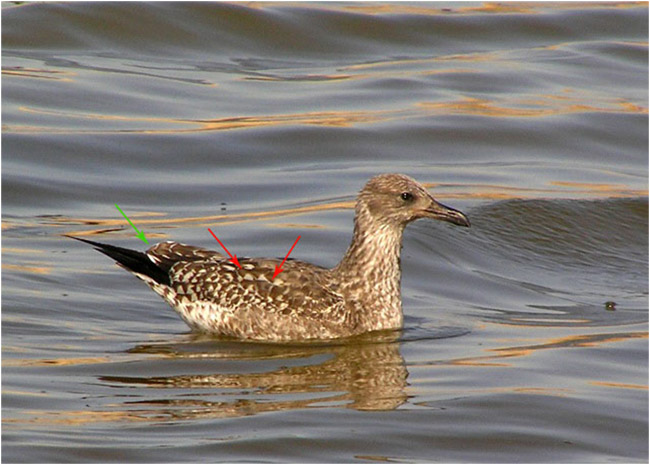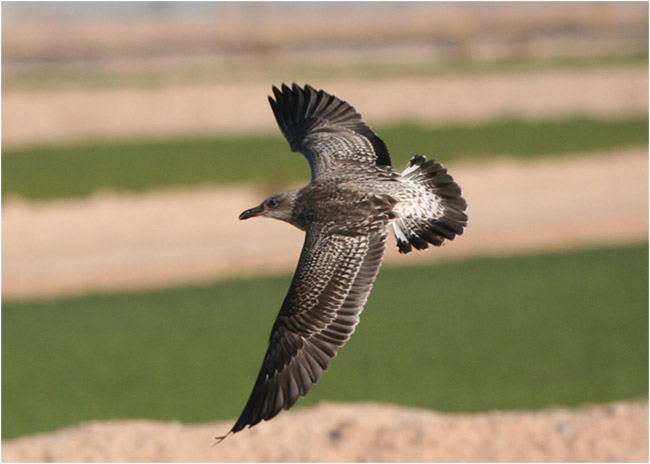 |
 |
|||||||||||||||||||||
|
||||||||||||||||||||||
Lesser Black-backed Gull (Larus fuscus), River Road Ponds, Maricopa County
Photographic summary and notes on identification of first cycle Lesser Black-backed Gull
Chris Benesh and Roy M. Jones
On 9 December 2006 birders visiting a small farm pond near Palo Verde, Maricopa County discovered a peculiar immature gull among Ring-billed Gulls. Pierre Deviche alertly took several photographs of the bird. The following day, Bill Grossi independently relocated the bird, took additional photographs, and recognized that the gull showed characteristics consistent with a first year Lesser Black-backed Gull. Subsequently, many birders were able to see and further document the bird, thus triggering much discussion on its identification. As the photos below illustrate, the combination of small size, distinctive structure, and specific plumage patterns seem to be enough to establish it as a Lesser Black-backed Gull. If accepted, this record will provide Arizona’s first for this long overdue species.
The so-called white headed gulls, with multiple stages of plumage changes, often pose some of the most complex identification challenges in the bird world. The vast majority of Arizona’s gulls are Ring-billed, with smaller numbers of California. A third scarce, but regularly occurring species is Herring Gull. It is primarily from these candidates that the identification of the Palo Verde gull must be sorted out.

Photo by Pierre Deviche
This first photo shows that many of the scapular feathers are fresh (red arrows), having been replaced by newer ones; this makes it a first-cycle gull (molting from juvenile to first basic). It bears a strong resemblance to a first-year California Gull. However, the vast majority of California Gulls have strongly two-toned bills by December. On the long-winged Lesser Black-backed Gull, the distance from the tip of the longest tertial (green arrow) to the tip of the tail is noticeably shorter than the distance from the tip of the longest primary to the tip of the tail. On the proportionally shorter-winged Herring Gull, these relative distances are more equal.

Photo by Chris Benesh
In this photo note the bird's slightly larger size compared to the surrounding Ring-billed Gulls. It can also be safely eliminated from a first-winter Ring-billed, and the same sized California Gull, by the all dark bill and dark underparts. The contrasting dark brown and white plumage helps to differentiate it from Herring Gull, which is 20-30% larger, and does not show such a whitish background color to the head and under parts.

Photo by Chris Benesh
In flight, it is apparent that this bird has a very different tail pattern than either

Photo by Chris Benesh
This photo illustrates a couple of important plumage distinctions that rule out a normal looking Herring Gull. First, there is very little contrast between the pattern of the inner and outer primaries. In Herring Gull, the inner 4-5 primaries (green arrows) are much paler gray than the remainder of the flight feathers, creating a pale window in that part of the wing. The greater secondary coverts (red arrows) are distinctively patterned in Lesser Black-backed Gull as well. Note how just the inner ones have pale internal markings while those covering the outer half of the secondaries are entirely dark with narrow pale fringing. This pattern is not shown by Herring Gull.

Photo by Pierre Deviche
Finally, this photo helps us to determine what subspecies or subspecies group this individual may come from. The axillaries match those of the western Palearctic group graellsii/intermedius in being predominantly dark with scattered paler barring, rather than having a whitish color with dense, dark barring of the eastern Palearctic group heuglini/taimyrensis. While the merit of this field mark is speculative at this time, it has been mentioned by some authorities as a potential way of differentiating between these two groups. Other more general differences may include a tendency for heuglini types to be more grayish toned, and more frosted in appearance compared with browner toned graellsii/intermedius.
References:
Martin Reid’s wonderful website is loaded with information and photographs.
http://www.martinreid.com/Gull%20website/lbbginx.html
Gulls of Europe, Asia and North America. Klaus Malling Olsen, Hans Larsson. A & C Black Publishers Ltd, September 20, 2004.
Acknowledgements:
We thank Pierre Deviche, Bill Grossi, Kurt Radamaker, and Gary Rosenberg for commenting on early drafts of this paper and for a lot of great discussions on the Palo Verde bird.
|
©2005
|
HOME | | | REPORT SIGHTINGS | | | PHOTOS | | | BIRDING | | | JOURNAL | | | ABOUT US | | | CHECKLISTS | | | AZ BIRD COMMITTEE | | | EVENTS | | | LINKS |